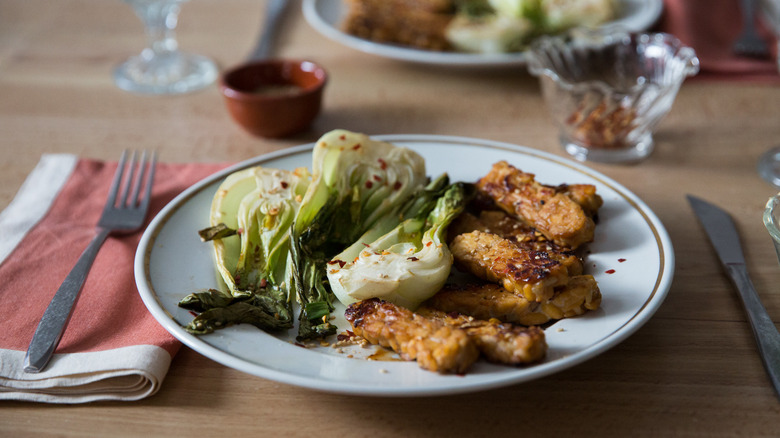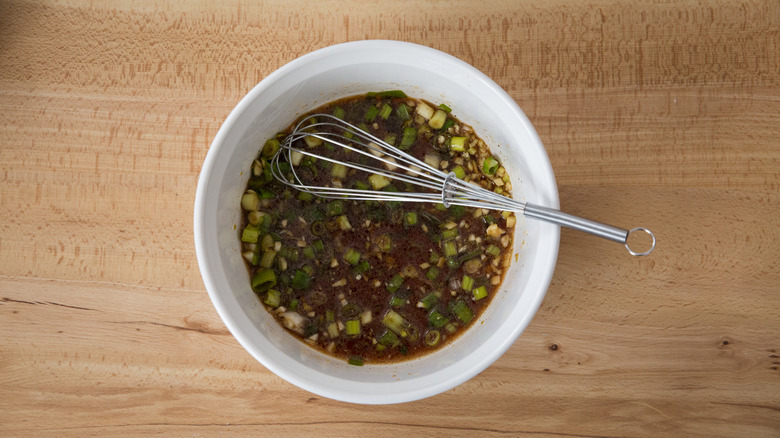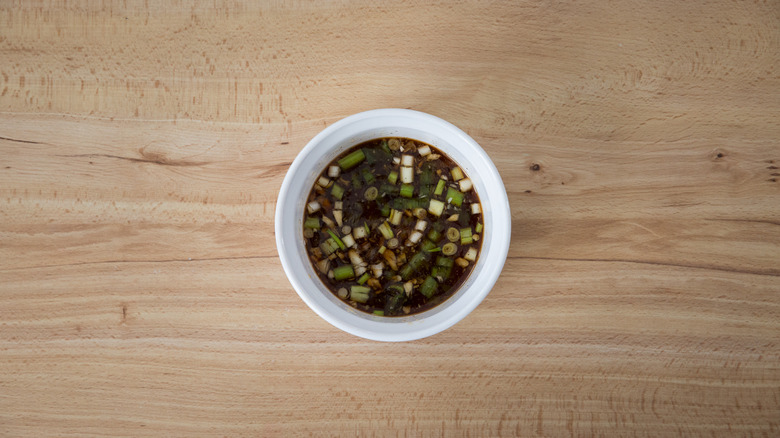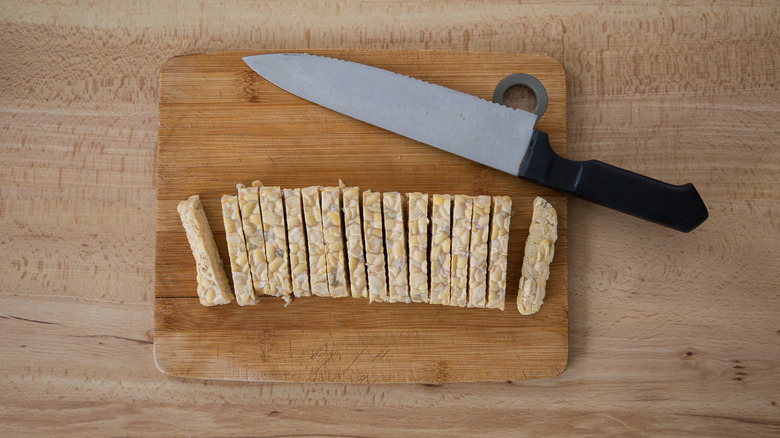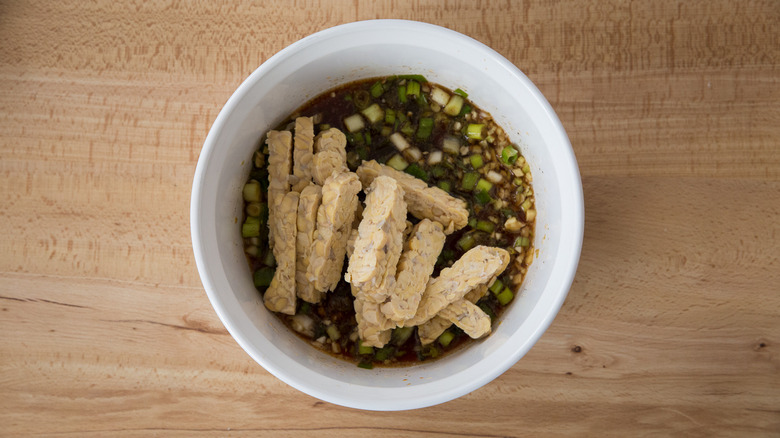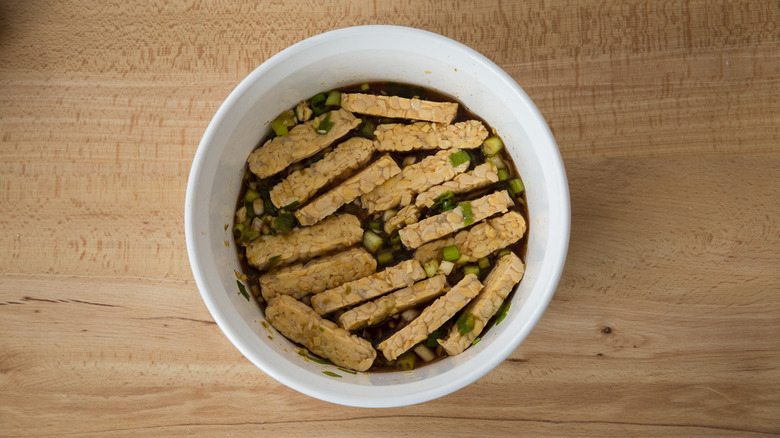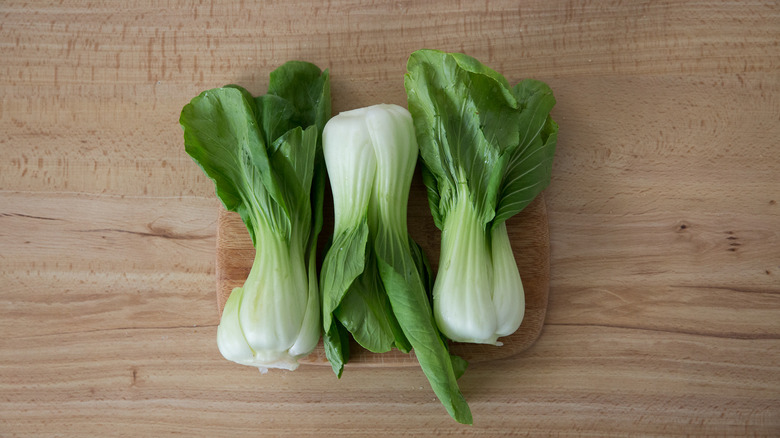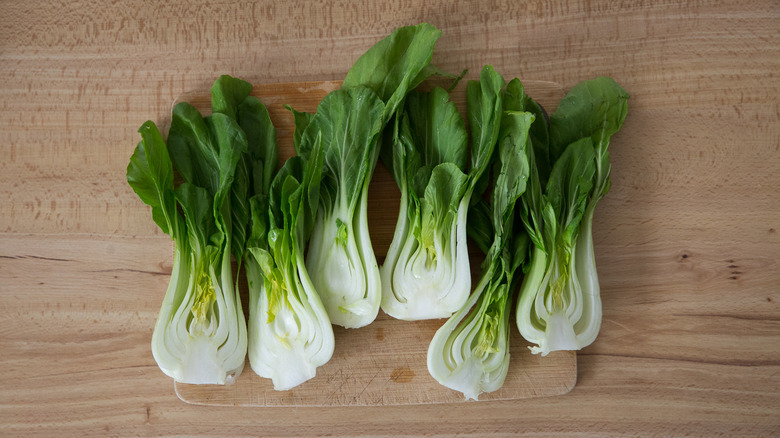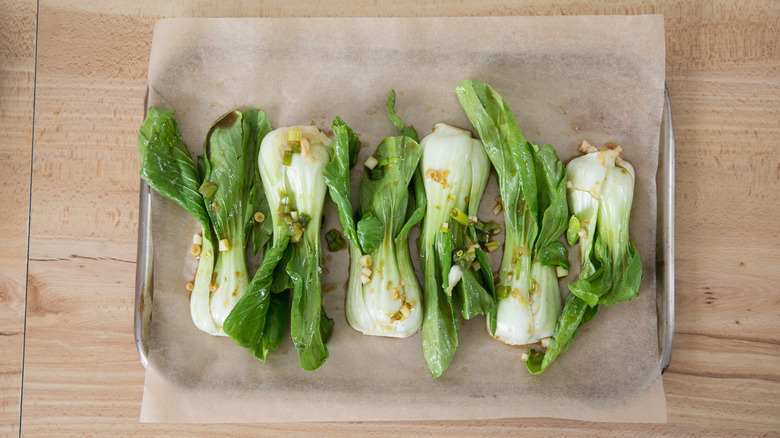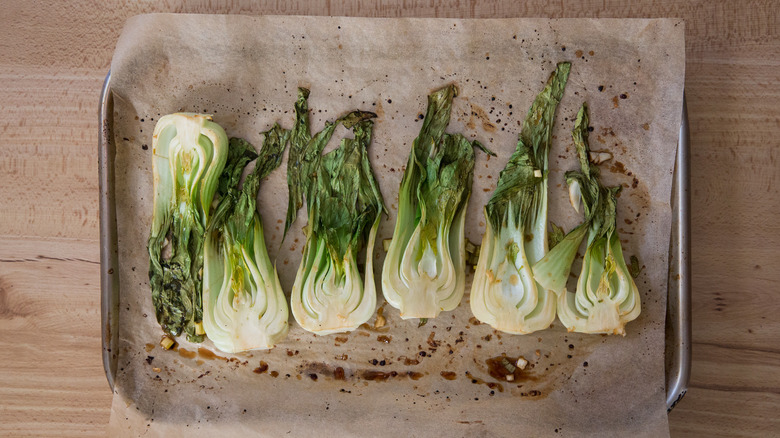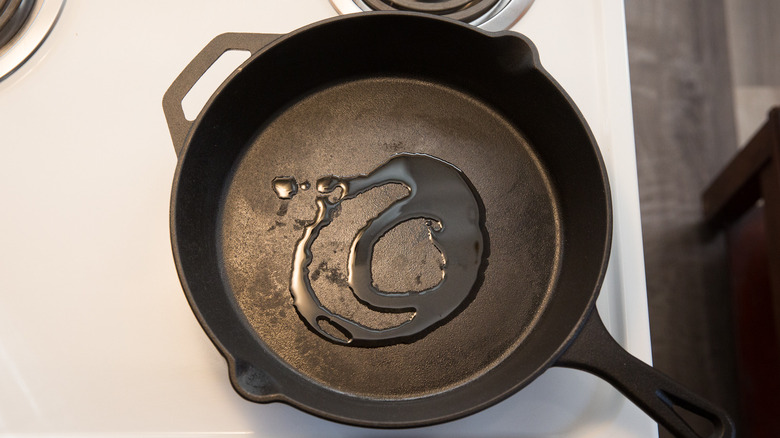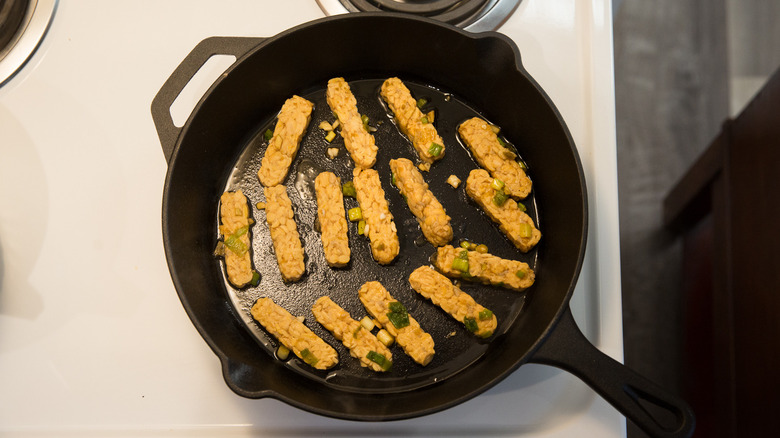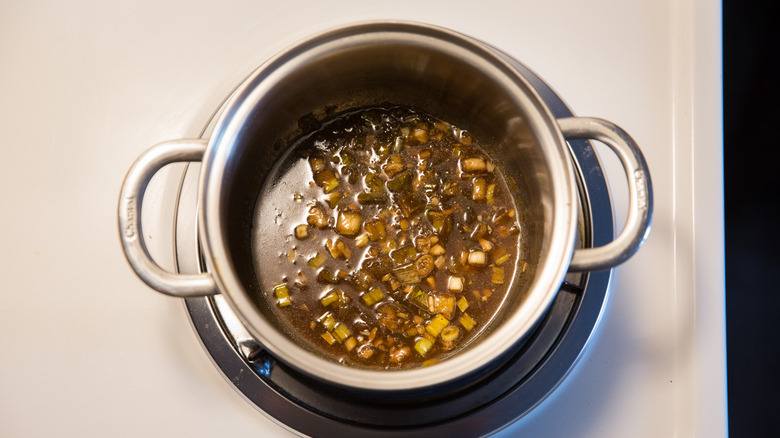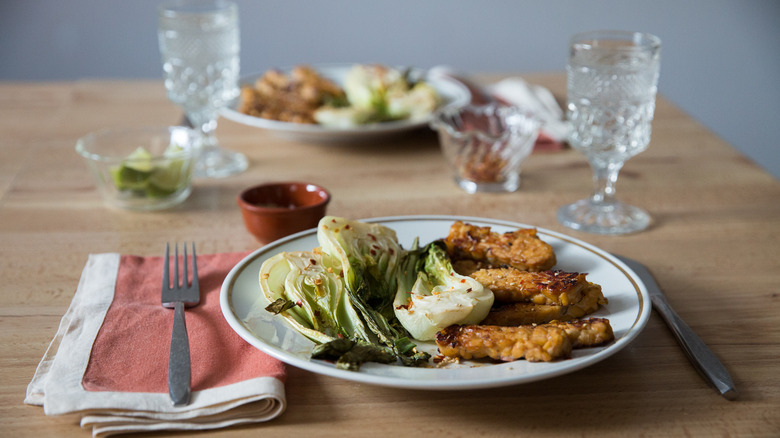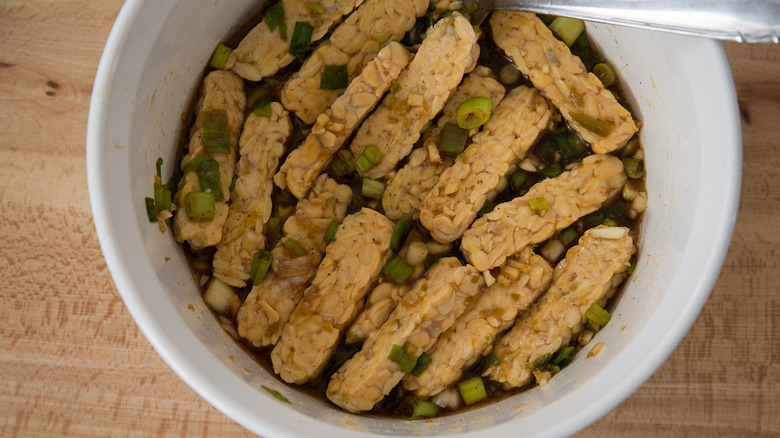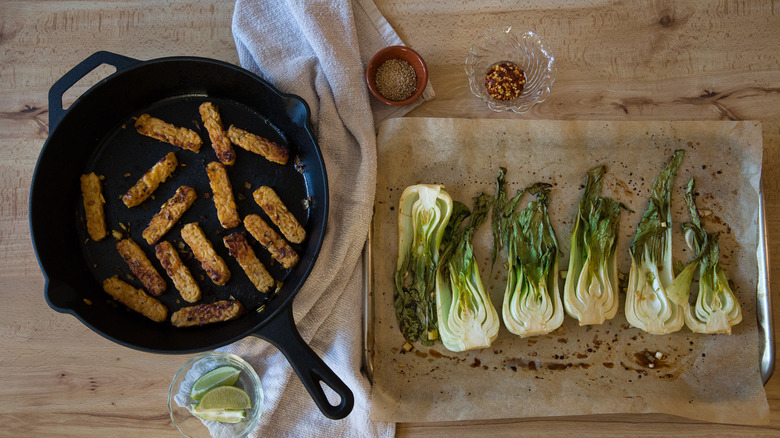Roasted Bok Choy With Crispy Tempeh Recipe
Bok choy, a type of Chinese cabbage, is a cruciferous vegetable and nutritional powerhouse just like other dark-green, leafy vegetables. Tempeh, while less well known as tofu, is a delicious, soy-based protein option that's a great addition to many people's kitchens. Tempeh is made from fermented whole soybeans that are pressed into a dense, rectangular cake that is sliced before cooking. It doesn't have a particularly strong taste, but some people describe it as nutty or even mushroomy. Like tofu, the flavor is enhanced by how it's cooked and what it's cooked with.
Recipe developer Michelle Bottalico has created this recipe for roasted bok choy with crispy tempeh that's as delicious as it's nutritious. These two ingredients are first marinated in a very flavorful, Asian cuisine–inspired marinade with ingredients like ginger, lime juice, rice vinegar, tamari, maple syrup, and chili garlic sauce. Marinating tempeh and bok choy enhances and complements the flavors of the original ingredients while also providing moisture. After marinating, the bok choy is roasted and the tempeh is pan-fried until crispy and irresistible. Top the final dish with white sesame seeds, red pepper flakes, and a squeeze of lime for a final result that's beautiful, colorful, healthy, and tasty.
Gather your roasted bok choy with crispy tempeh ingredients
For this recipe, you'll first need tempeh and baby bok choy. If you're not familiar with tempeh, it can often be found at one end of the produce section of the grocery store near the tofu and meat alternatives. Both of these ingredients will be marinated in a flavorful marinade. The marinade calls for ginger, garlic, scallions, and lime juice from the produce department, as well as rice vinegar, tamari, sesame oil, chili garlic sauce, maple syrup, salt, pepper, and water or vegetable broth. You can use soy sauce instead of tamari if you prefer, and the chili garlic sauce can be homemade or store-bought, depending on your preferences. You'll need sesame oil for frying the tempeh. Finally, the dish is garnished with white sesame seeds, red pepper flakes, and additional lime juice before serving.
Step 1: Make the marinade
To make the marinade, place all the marinade ingredients in a large bowl and whisk well to combine. Taste and adjust for salt or other seasonings, if necessary.
Step 2: Reserve part of the marinade
Remove ⅓ of the marinade and place it in a small bowl. Set aside.
Step 3: Slice the tempeh
Slice the tempeh into thin slices about ⅜-inch (1-centimeter) thick.
Slide 4: Place the tempeh in the marinade
Place the tempeh slices in the large bowl with the greater portion of marinade.
Slide 5: Let the tempeh marinate
Use a spoon to gently coat all the tempeh slices with the marinade. Let it sit for at least 30 minutes and as long as overnight, stirring gently and turning the tempeh occasionally to evenly coat both sides. Refrigerate the bowl if marinating for more than 1 hour.
Step 6: Preheat the oven
Preheat the oven to 400 F.
Step 7: Wash the bok choy
Thoroughly wash the boy choy to remove any dirt, and dry well.
Step 8: Slice the bok choy
Cut the lower ends off each bok choy, then slice the bok choy in half lengthwise.
Step 9: Brush bok choy with marinade
Generously brush each piece of bok choy on both sides with marinade reserved in the small bowl. Place the pieces face down on a parchment paper–lined sheet pan.
Step 10: Roast the bok choy
Roast the bok choy for up to 10 minutes, flipping them halfway through. They'll be done when the leaves are crispy and the bulbs are tender and can be pierced with a fork.
Step 11: Heat the oil
While the boy choy roasts, heat sesame oil in a large skillet on medium.
Step 12: Fry the tempeh
Using tongs, transfer the tempeh slices to the skillet and fry in a single layer for 4–5 minutes per side, until crispy and slightly blackened. Before flipping, brush the slices with a little marinade if they get too dry. Don't add too much, or the marinade will burn.
Step 13: Cook the marinade
Place the excess marinade in a small saucepan. Heat it to a simmer and let it cook for 10 minutes to make a sauce.
Step 14: Serve the roasted bok choy with crispy tempeh
Plate the roasted bok choy and tempeh together on a plate and top with white sesame seeds, roasted red pepper flakes, and a splash of lime juice. Serve immediately with the reduced marinade on the side.
Can I make tempeh less bitter before making this crispy tempeh recipe?
The human taste bud varies among people, with some people loving tempeh right out of the package and others finding it has a bitter taste. Tempeh is not supposed to be very bitter, but another reason it can taste this way is because of variations in the fermentation process. Namely, over-fermentation and the addition of vinegar can produce different levels of bitterness among different batches or brands.
If tempeh tastes good to you, just use it in the recipe the way it is. You can taste a bit right out of the package to sample the flavor. Some people have concerns about eating it raw because it's a fermented food containing bacteria. We don't recommend eating homemade tempeh raw, and you should also stick to good-quality, pasteurized tempeh that's not expired.
If the tempeh tastes bitter to you and you'd like to remove that taste, there is an easy fix. You just have to boil it first. Slice the tempeh the way the recipe calls for, and then place the slices in boiling water and cook them for 5 minutes. Drain them and let them cool before marinating them. Some people enjoy boiled tempeh more because boiling also makes it a little more tender.
I don't like tempeh. Can I use tofu in the crispy tempeh recipe?
Yes, you can easily substitute the tempeh in this recipe for tofu instead. They are both soy products commonly used in Asian recipes and can often be substituted for one another, but they are not the same. Tempeh is a thin, fermented cake made from whole soybeans. It's quite firm, and while the flavor isn't particularly strong, it's stronger than tofu's. The whole soybeans being pressed and melded together gives it a bumpy texture. The color is beige, and you'll sometimes see specks of brown if additional ingredients, such as seeds, are added.
Tofu is made from curdled soymilk. The curds are drained and pressed into a thick block. The color is a whitish-beige, and it doesn't have much of a flavor on its own. It develops flavor from the other things it's cooked with. Tofu is sold in various consistencies, from soft silken tofu to extra-firm varieties. When you're using tofu in recipes that call for tempeh, make sure to use the extra-firm kind for the best results. It will slice and hold up in the pan better and has a lower chance of crumbling to pieces. There's no need to boil tofu first, but you'll want to press it and drain it well to remove the higher water content before cooking with it.
Roasted Bok Choy With Crispy Tempeh Recipe
This recipe for roasted bok choy with crispy tempeh gets its flavor from a spicy-sweet-salty marinade that coats both the vegetable the plant-based protein.
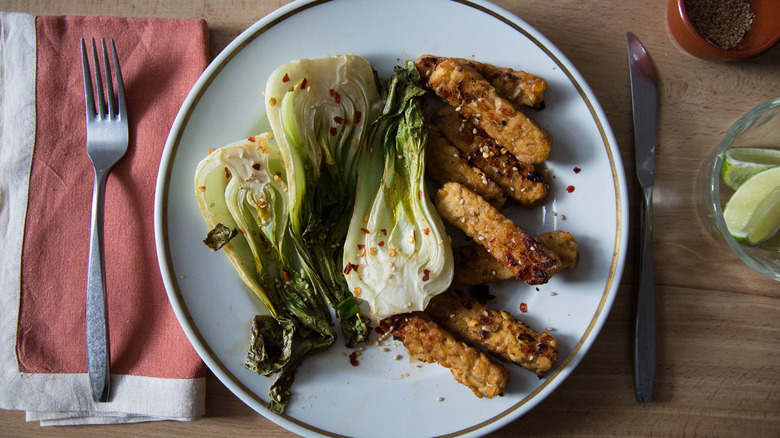
Ingredients
- For the marinade
- ¾-inch piece ginger, peeled and finely minced
- 1 ½ cloves garlic, minced
- 5 scallions, thinly sliced
- 3 tablespoons lime juice
- 2 ½ tablespoons rice vinegar
- 4 tablespoons tamari
- ½ tablespoon sesame oil
- 2 teaspoons chili garlic sauce, or to taste
- 1 ½ tablespoons maple syrup
- ¼ teaspoon black pepper
- ¼ cup + 2 tablespoons water or vegetable broth
- Pinch of salt
- For the bok choy and tempeh
- 8 ounces tempeh
- ½ pound baby bok choy
- ½ tablespoon sesame oil
- Lime juice, for serving
- White sesame seeds, for garnish
- Red pepper flakes, for garnish
Directions
- To make the marinade, place all the marinade ingredients in a large bowl and whisk well to combine. Taste and adjust for salt or other seasonings, if necessary.
- Remove ⅓ of the marinade and place it in a small bowl. Set aside.
- Slice the tempeh into thin slices about ⅜-inch (1-centimeter) thick.
- Place the tempeh slices in the large bowl with the greater portion of marinade.
- Use a spoon to gently coat all the tempeh slices with the marinade. Let it sit for at least 30 minutes and as long as overnight, stirring gently and turning the tempeh occasionally to evenly coat both sides. Refrigerate the bowl if marinating for more than 1 hour.
- Preheat the oven to 400 F.
- Thoroughly wash the boy choy to remove any dirt, and dry well.
- Cut the lower ends off each bok choy, then slice the bok choy in half lengthwise.
- Generously brush each piece of bok choy on both sides with marinade reserved in the small bowl. Place the pieces face down on a parchment paper–lined sheet pan.
- Roast the bok choy for up to 10 minutes, flipping them halfway through. They'll be done when the leaves are crispy and the bulbs are tender and can be pierced with a fork.
- While the boy choy roasts, heat sesame oil in a large skillet on medium.
- Using tongs, transfer the tempeh slices to the skillet and fry in a single layer for 4–5 minutes per side, until crispy and slightly blackened. Before flipping, brush the slices with a little marinade if they get too dry. Don't add too much, or the marinade will burn.
- Place the excess marinade in a small saucepan. Heat it to a simmer and let it cook for 10 minutes to make a sauce.
- Plate the roasted bok choy and tempeh together on a plate and top with white sesame seeds, roasted red pepper flakes, and a splash of lime juice. Serve immediately with the reduced marinade on the side.
Nutrition
| Calories per Serving | 392 |
| Total Fat | 19.5 g |
| Saturated Fat | 3.9 g |
| Trans Fat | 0.0 g |
| Cholesterol | 0.0 mg |
| Total Carbohydrates | 32.5 g |
| Dietary Fiber | 3.0 g |
| Total Sugars | 12.8 g |
| Sodium | 2,049.6 mg |
| Protein | 29.4 g |
